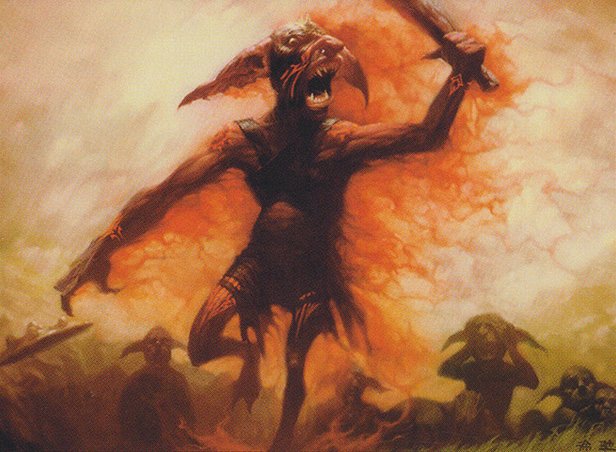A Planeswalker’s Guide to Zendikar: Goblins
This content was deleted from the Magic website during an update. The original page can be accessed via Wayback Machine here.
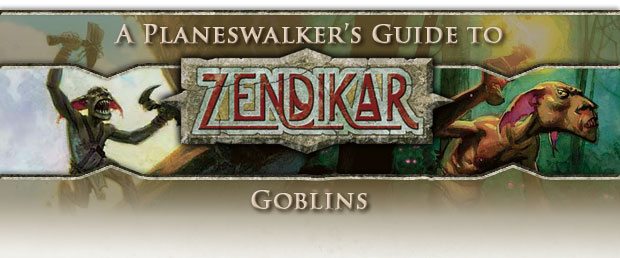
Goblin Physiology
The goblins of Zendikar are similar in appearance to goblins found in other planes. between 3.5 and 5 feet in height, but with a slender, more elongated build. Their arms are unusually long, allowing them to brachiate through forest canopies and along cliff walls, and their skin is more leathery than typical goblin skin. A goblin’s skin will range from a brownish red to a moss green, depending on his tribe and his exposure to various subterranean elements.
Social Structure and Leadership
Goblins practice a strange form of meritocracy when it comes to governance. By far, the most useful trait in a leader is practical survival knowledge, so the goblin that leads the tribe is the one who has managed to retrieve the most interesting or powerful object from a ruin site. As such, ambitious goblins are always trying to outdo one another, and delve deeper and deeper into ever more dangerous ruins. Goblin leaders therefore tend to be young—there are old goblins, and ambitious goblins, but there are very few old and ambitious goblins.

Talismans
Goblins always carry their most impressive prize with them, and a goblin that hasn’t yet retrieved an interesting relic from some ruin or wilderness locale is not considered a full member of the tribe. However, most goblins are fearful by nature individually, so they are willfully gullible when told that a given object is an important artifact. They enable each other’s cowardice through a tacit agreement to the effect that, “Yep, that hunk of rock you found feels pretty powerful to me,” thereby enabling each others’ acceptance by the tribe.

“Survival rule 502: Every hunk of rock is trying to kill you.”
Zurdi, goblin shortcutter

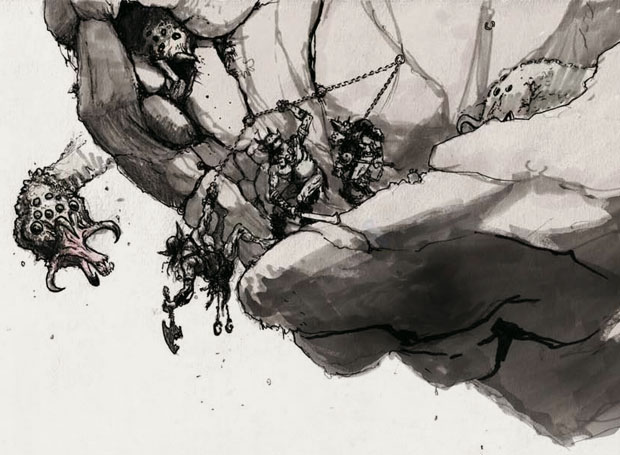
“Grit” and Goblin Skin
“Grit,” an unidentified mineral commonly found in volcanic rock and magma tunnels, is often pounded into dust and eaten by goblins, and it serves to partially calcify their skin—enough to toughen them up against the elemental forces they are constantly subjected to. As goblins age, therefore, their skin develops a stiff, leathery quality like elephant skin. An older goblin starts to look greyer and stonier over time.
Zendikar is home to three major loose tribes of goblins and numerous smaller ones.
The Tuktuk Tribe
The Tuktuk tribe’s leader is not exactly a goblin. A goblin explored deep into an ancient ruin, where he triggered an ancient magical rune-trap that instantly killed and then, bizarrely, replicated him. This replica possessed fragmented memories as well as fragmented commands from the magic that animated it, but the two sets of experiences proved incompatible. The replication process aborted, leaving a stone body that mostly looked like a goblin.
The construct managed to return to its home. His name, “Tuktuk,” taken from an obscure goblin concept related to bravery, took on new meaning based on the ticking sound emanating from his body. It was obvious to the rest of his tribe that he had brought something amazing back from the ruins, and his physical strength was clearly amplified. As such, the tribe made him chief, and he has been leading them for fifty years—much longer than an average goblin’s natural lifespan, and nearly five times the length of an average goblin’s actual lifespan.
“That’s enough now, Togli. We have to move—no more little rituals. That roil elemental’s bearing down on us—it’ll start tearing us apart in a matter of hours. …No, actually, Zajara with the spyglass says minutes. The party can’t wait for you while you commune with your useless Tuktuk. I don’t—I don’t care if there are ancient runes, nothing they could possibly say would make me want to stick around here…. A secret tunnel, huh? Straight down? …Treasure chamber? Zajara!”
Sachir, Akoum Expeditionary House
Tuktuk’s conflicting internal motivations, through bizarre chance, make it an excellent goblin leader. The construct mind within it wants to keep certain ancient sites undisturbed, so it is able to steer its tribe clear of dangerous areas of ruins. Even more helpfully, the replica partially understands some of the relics that his tribe’s adventurers return with. Compared to goblins of other tribes, a Tuktuk shaman is much more likely to actually know how to activate relics he has recovered. Whether it’s a good idea to do so is another question entirely.
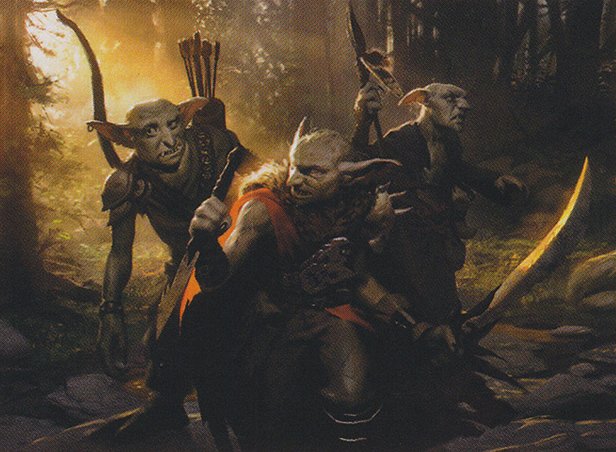
Tuktuk are most likely among the goblins to hire themselves out as ruin guides to other races. Of course, the normal plan is to help find something of value, steal it, trigger a trap intentionally, and run like hell.
“Survival rule 124: Treasure’s in hand? Job’s over.”
Zurdi, goblin shortcutter
The Lavastep Tribe
The Lavastep tribe is the most industrious of the goblin tribes, with hard-won knowledge of the geothermal activity in Akoum. Much more than the other tribes, the Lavasteps build surprisingly effective equipment out of the crystal shards and veins of strange metals that occasionally boil up to the surface. The most warlike of the goblin tribes, the Lavasteps frequently harass the kor, elves and humans that have taken residence on the surface.
“It’s bad enough we’ve got geoquakes wrecking the outer walls and lagac lizards eating the patrols. But now the Lavasteps’ve decided the whole outpost is blocking their fissure. Three attacks in a week—not just swords and scramblers, but they’ve got full-on pyro too. Send whatever you can spare, warriors or healers or whatever you’ve got, and we won’t forget it.”
Kadiwa the Defiant, letter to the Guardians of Affa
Lavastep shamans tend to be primitive alchemists and experiment with the strange gases and fluids that emerge from newly formed volcanic fissures. When facing a Lavastep, expect to have clay vials and skin bladders full of acids, gases, slimes and other nasty, quasi-magical concoctions thrown at you.
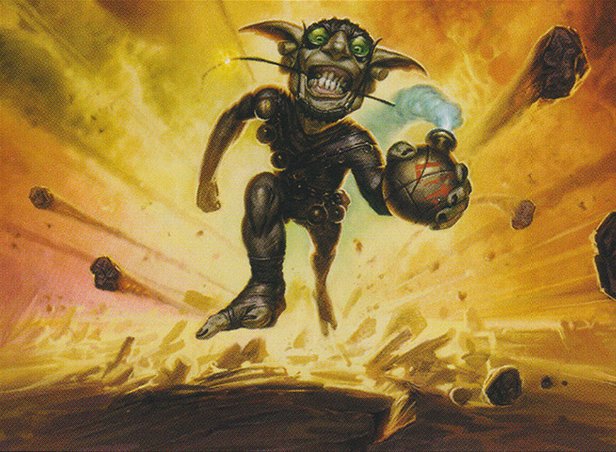
Lavasteps ingest much more grit than the other tribes, and a typical Lavastep goblin’s appearance will be quite wrinkled and gray. Experienced warriors will often take on such a rocky appearance that they can hide nearly undetected among the stalagmites, able to ambush foes, predators or prey.
More than the other goblin tribes, the Lavasteps have a somewhat coherent religious aspect to their lives, believing that the fires beneath the earth are sentient. The vapors that their priests and prophets inhale are in fact thought to be messages from the fiery gods in the depths. Fire worship is not for the faint of heart—ritual burning and scarification leave most Lavasteps extremely tolerant to heat and flame, and due to the tissue damage, almost incapable of feeling pain. This makes a Lavastep a dangerous opponent in battle, as they will often fight to the bitter end.

Although most goblins can see quite well in the dark, many Lavastep explorers take a very small, well-covered lantern with them, the flame kept as close to ever-burning as possible, for religious reasons.
Zurdi, goblin shortcutter
“Survival rule 883: Fire distracts the eye of danger and warms the heart of fortune.”
The Grotag Tribe
The Grotag are clever by goblin standards, and that hasn’t helped them one bit. Smaller and weaker than their cousins, with larger hands and feet, the Grotag have tried to live by their wits—not a winning proposition. Ingenuity is prized among the Grotag, so when a goblin has the bright idea of trying to tame fleshpiercer mites, there are at least a few who are willing to follow that goblin into a nest, to predictably horrible results … most of the time. While the Grotag seem to have a never-ending supply of bad ideas, and a horrible ratio of bad ideas to good, the Grotag also seem to have a never-ending supply of Grotag. As such, by trial and error (and more error), the Grotag have stumbled across a great deal of knowledge useful for surviving the deep places of Bala Ged and for dealing with the creatures that live there.
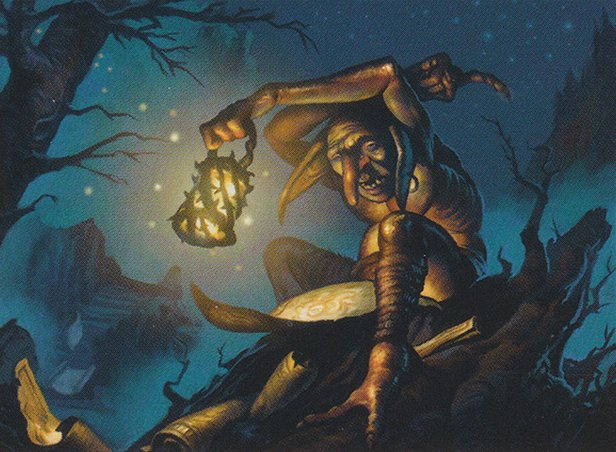
Grotag goblins imagine themselves to have a sort of empathy with beasts, and they lose hundreds of goblins each year to ill-advised monster taming attempts. But, every now and again, one of these efforts is successful. Grotag are the only goblins to successfully (at least, sort of successfully) domesticate other animals—namely the lagac lizard, large enough to ride or pull a makeshift cart or sleigh, and the ventcrawler, a slow-moving arachnid the size of a car, which enjoys feeding on the charred bodies of creatures caught in lava flows or deadly steam bursts. Occasionally, a Grotag will come home with a more exotic pet, like a drake or a hydra hatchling. Usually, this results in slapstick slaughter.
“At first I thought I had gotten some kind of screaming deal. The Grotag merchant just handed me the reins and left—forgot to take any kind of payment. My lucky day, I thought: a three-ton geopede, Grotag-tamed, for nothin’. Then I realized I wasn’t holding reins, but just some residual entrails hanging from its mouth, the remnants of its last meal. It started thrashing, of course, and nearly took my arm off—and then it nearly killed my whole expedition. Then I understood why the goblin made me agree to ‘no refunds.'”
Mitra, Bala Ged missionary
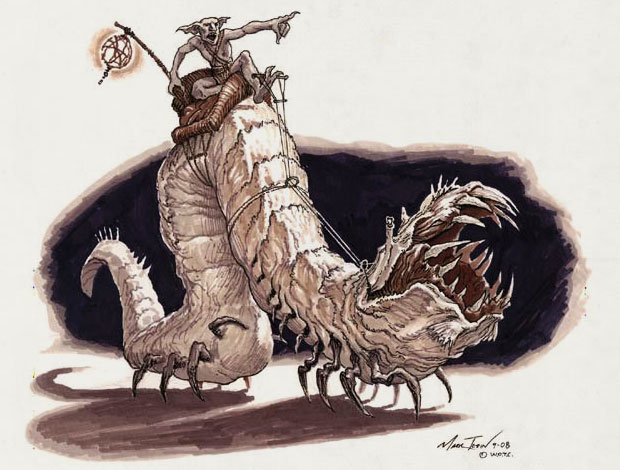
Grotag are not as insular as other goblins, and are willing to trade their fungal crops and mineral finds for goods from other races. The infamous Grotag curiosity will also lead many members of the tribe to live among other races, whether those other races like it or not. These “bounders,” as they’re often called (due to the fact that they often need to run to keep up with their chosen travel companions), tend to be harmless and friendly enough that their “hosts” have a hard time kicking them out of their settlements or travelling bands. However, a friendly group of humans or kor tends to get a lot less tolerant when a Grotag brings home a pet.
The Fissure Goblins of Ondu
Most of the goblin warrens built into the Makindi Trenches are built into exposed rock faces, but some goblin communities gravitate toward small, tight fissures between boulders and converging crags. These fissure goblins have an uncanny affinity for the geology of the region; some of their warriors are hired as climbing guides, and some of their shamans are consulted as oracles of earthquakes and gravity shifts.

The Goblin Dynasties of Beyeen
The goblins of the Beyeen region of Ondu move from mountain peak to mountain peak, experts at locating ore, obsidian, and gems. They keep the volcanic forces of the island appeased with sacrifices of fruit and gemstones, but still fall prey to most of the predators in their environment. Though their culture appears to be simple to outsiders, the Beyeen goblins actually have a deep dynastic history tracing back generations. Their history is traced out in swirling colors on a miles-long cave mural, called the Beyeen Vein, in the tunnels deep under the mountain Valakut.
The Gas-Talkers of Akoum
Much of goblin society is centered around the role of the shaman, and some goblin shamans will intentionally breathe the volcanic gases that erupt from deep within the ground. While goblin physiology is more adapted to these gases than, say, elves or humans, the results can still be very harmful. Great, chaotic magical energy is trapped in the volcanic caldera below, and as such, the gases often imbue the shaman with magical power and/or visions, if only for a little while. These “gas-talkers” are revered, but often from a safe distance.

“Day eight inside the puzzle tower of Tal Terig. The walls shift here, and foul-smelling vapor leaks out from between the tile seams. The only one who doesn’t seem to mind is Jingi, our goblin porter, which worries me. She enters a kind of trance, and chants—ominous things—that have fortunately failed to come true, so far. My contract specifically said no shamans, but now I wonder if we’d even have made it this far if Jingi hadn’t been along. It’s just unnerving to watch her eyelids flutter and her tattoos … move.”
Bratash the Ruin Delver
The Song-Mad Goblins of Murasa
Goblins that explore too deeply and too often into the Singing City in Murasa inevitably go “song-mad.” These poor wretches are banished from their tribes to stumble drunkenly about the Singing City, absently crooning its song. Left in the City, they are harmless and eventually waste away, but removing a song-mad goblin far enough that it can’t hear the City’s singing drives it into a frenzy. Goblin tribes at war with one another often sweep the City to gather as many of the song-mad as they can. They then strap blades to them and tie weapons into their fists. These song-mad goblins are driven into battle by other goblins wielding “mancatchers” and then released among the foe. The screeching creatures thrash wildly about, causing havoc and casualties until killed or turned back to thrash among those who brought them to war.
